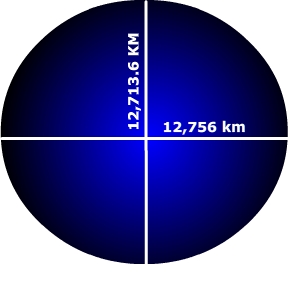Size and Shape Those involved in the study of measuring the Earth, called geodesists, don't know exactly what the true shape of the Earth is. We often describe it as a sphere but it's more like an oblate spheroid. That is, Earth is wider in the middle and flatter at the poles than a perfect sphere. From pole-to-pole the distance is 12,713.6 km. The equatorial diameter Earth is about 7926 miles (12,756 km) while the polar diameter is 7900 miles (12,714 km). The equatorial circumference is approximately 24,900 miles (40,075 km). The equatorial bulge is due to the centrifugal force exerted on the Earth by its rotation.
Figure 2.8 Oblate spheroid On December 26th, 2004 subduction occurred between the India and Burma plates off the coast of Indonesia making for a slightly more compact Earth. The shift in Earth's crust resulted in a magnitude 9 earthquake and large tsunami that devastated South Asia. Interestingly, Earth became slightly more round and the North Pole shifted by about 2.5 cm (an inch) in the direction of 145 degrees East longitude (Science Daily, 2005). From the top of Mt. Everest at 29,029 feet (8848 m) in the Himalayas, to the depths of the Mariana Trench in the Pacific at 36,198 feet (11,033 meters) below sea level, Earth has a total relief of about 12 miles. Though this seems to be a great distance, it's a mere blip when compared to the diameter of Earth.
|
 Figure 2.7 Taking readings from a
GPS atop the US capitol building
Figure 2.7 Taking readings from a
GPS atop the US capitol building